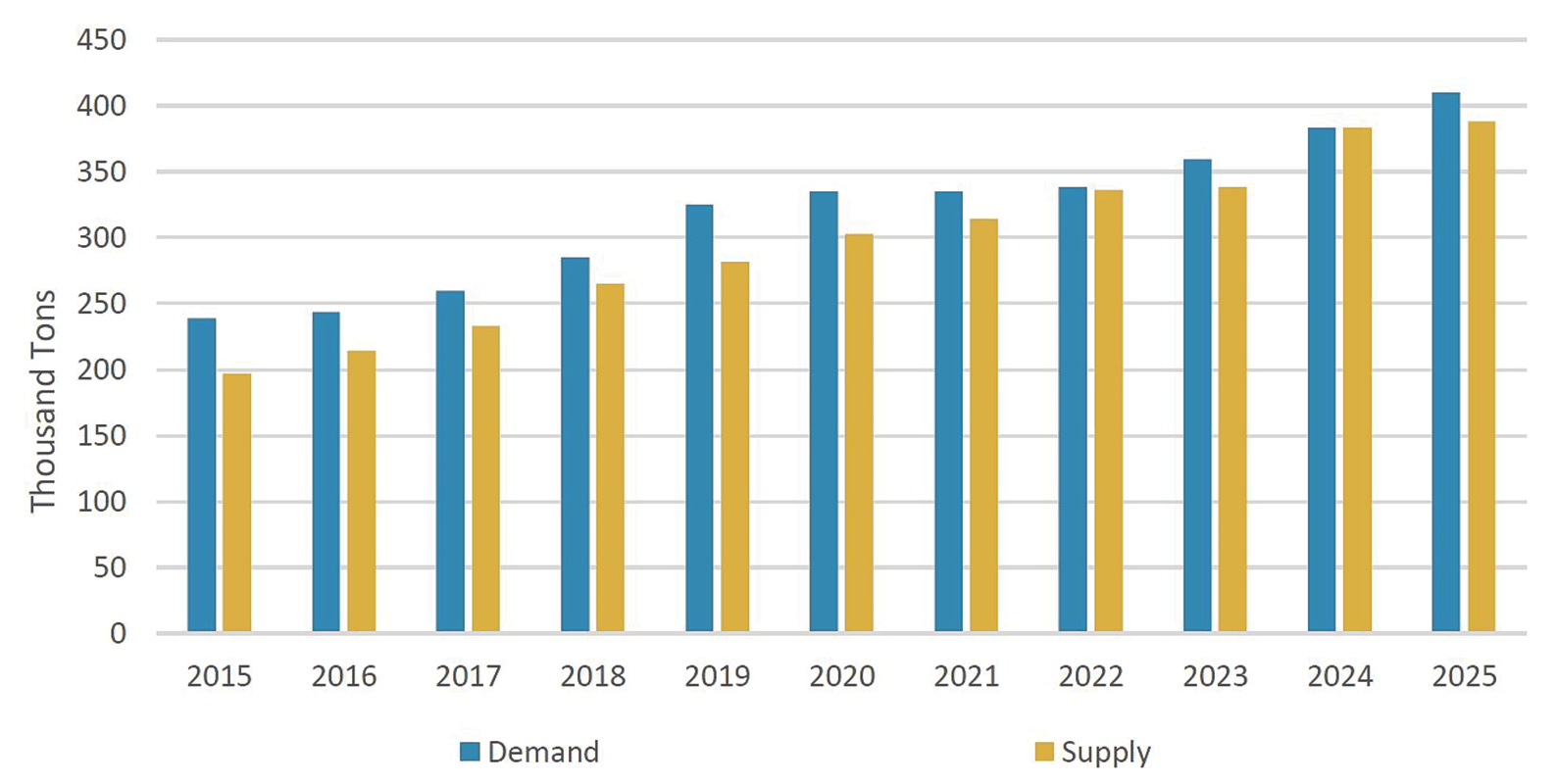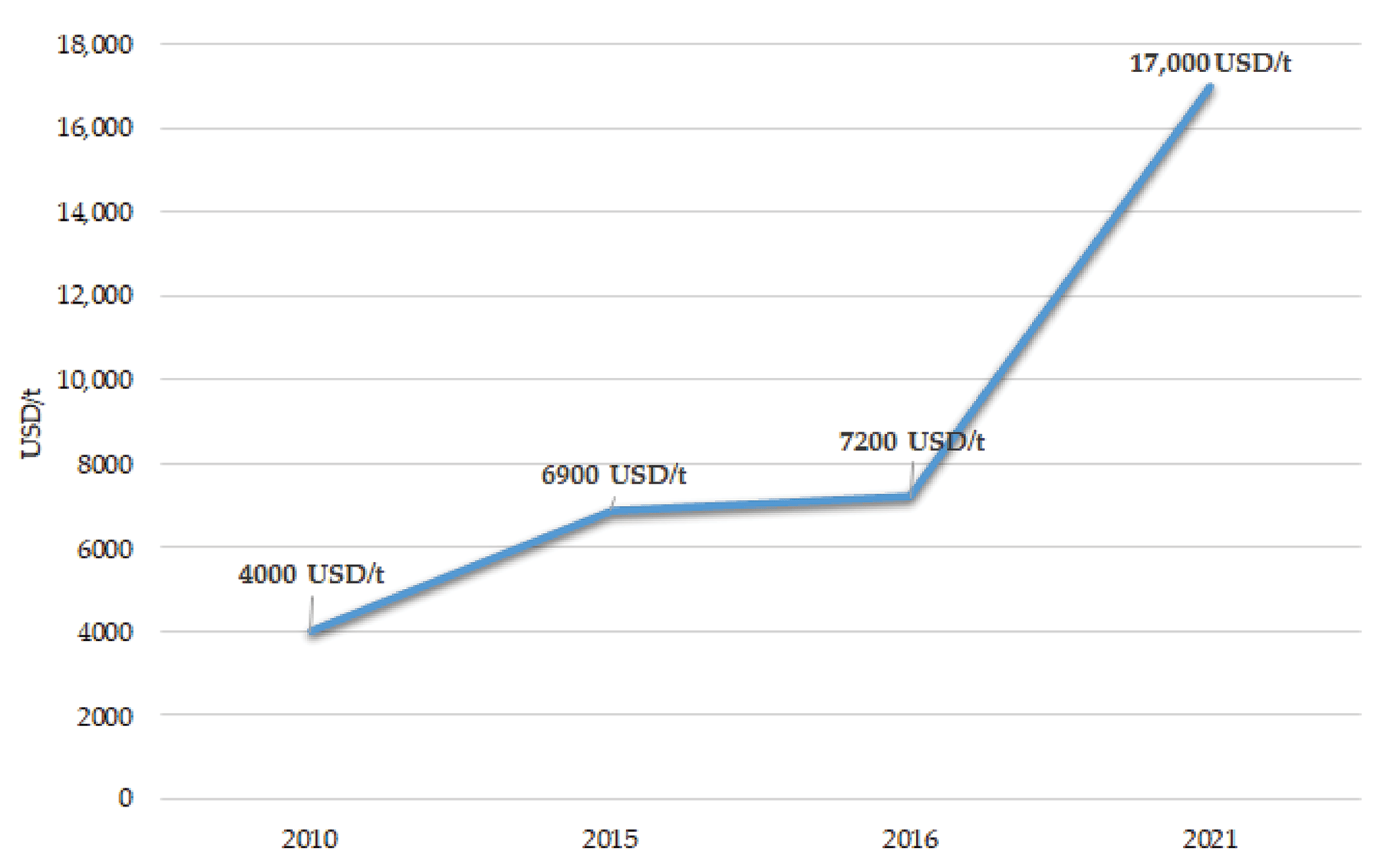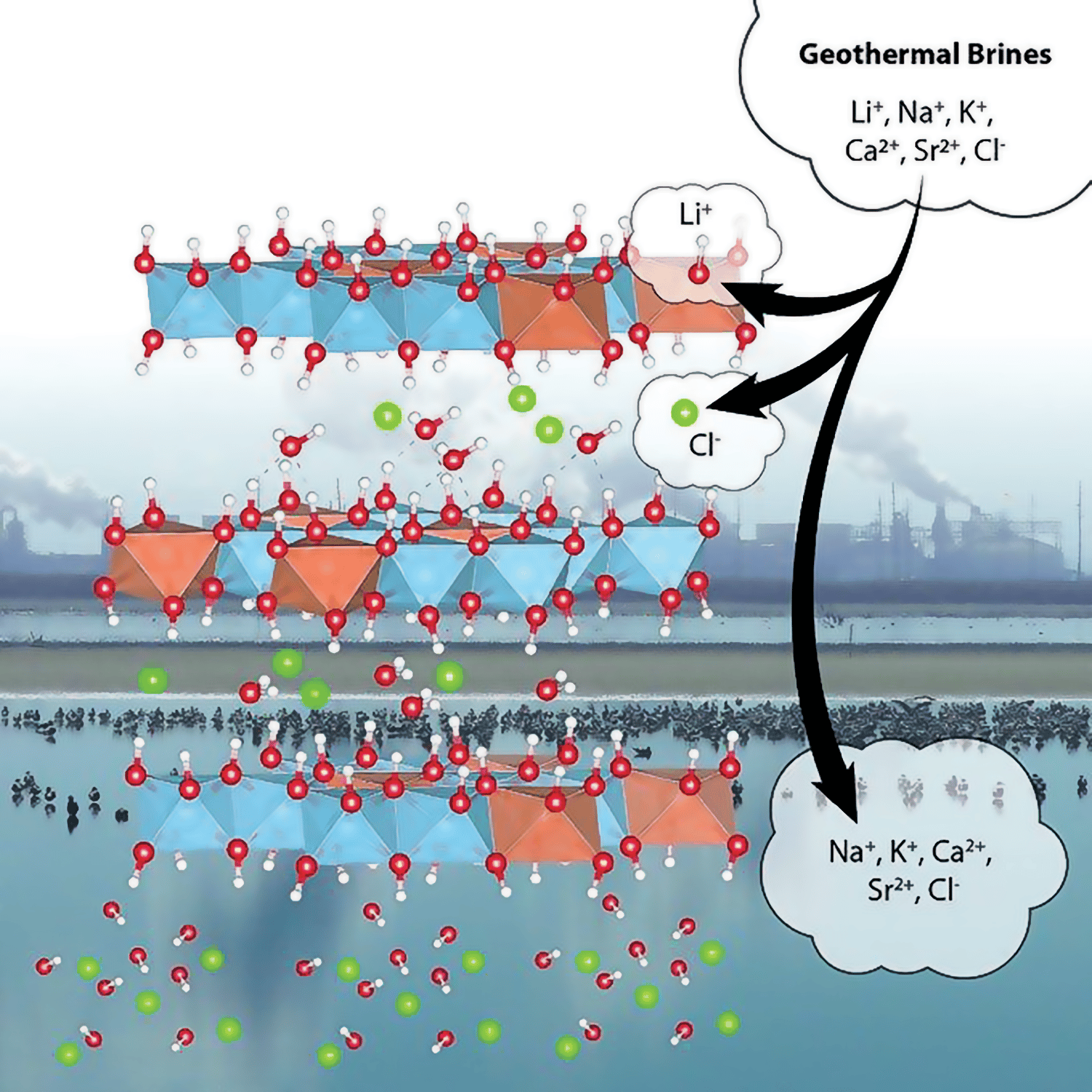bulletin | cover feature
Lithium:
The 21st century ‘gold’ rush
A core sample from the Thacker Pass Project in Nevada, which is an open-pit lithium mine located within the extinct McDermitt Caldera supervolcano.6
The increasing global demand for lithium has governments and companies around the world considering how to ensure enough supply of this valuable metal.
By Eileen De Guire
Lithium. Element 3 on the periodic table. The lightest of metals. And a global, multibillion-dollar industry.
Demand for the little element has skyrocketed with burgeoning demand for portable energy, i.e., batteries. Myriad rechargeable devices as varied as laptop computers, cell phones, pacemakers, and power tools use lithium-ion battery (LIB) packs to supply their portable power. But perhaps the biggest devices deploying LIBs are electric vehicles and grid-storage batteries. These devices, especially the former, have eclipsed demand for lithium from every other application.
Batteries are not the only use for lithium. The ceramics and glass industry has long used lithium carbonate as a key raw ingredient for glass-ceramic products with low or near-zero coefficients of thermal expansion. Famously used for cookware, these glass-ceramics also find applications in telescope mirrors and mirror mounts and other applications where thermal stability is critical. Other ceramic and glass uses for lithium include as glaze fluxes, in lithium niobate electro-optic components, and as concrete additives to slow down damaging alkali–silica reactions.
Other uses for lithium include pharmaceuticals, greases and lubricants, continuous casting mold flux agents, and aluminum alloying. The nuclear power industry uses Li-7 isotope additives in pressurized water reactor cooling systems to stabilize pH for corrosion control.
With such a high demand for this metal from so many different industries, governments and companies around the world are concerned about having access to enough supply. For example, most critical materials lists within the International Energy Agency’s policies database identify lithium as a strategic, critical mineral.1
Lithium minerals market
Lithium sources
Like most raw materials, lithium-containing resources are not distributed evenly across the globe. In its annual Mineral Commodity Summaries report,2 the U.S. Geological Survey estimates there are 26 million tons (Mt) of lithium reserves globally. Chile and Australia are the big winners with 9.6 Mt and 6.2 Mt, respectively. Argentina is positioned to be a major producer with 2.7 Mt of identified reserves. China reports 2 Mt, and the U.S. and Canada combine for 1.93 Mt. Other countries with commercially interesting reserves include Zimbabwe and Brazil. Another 4 Mt are scattered throughout Europe, Africa, and Mexico.
Australia is the largest producer of lithium, which it extracts from lithium-bearing ores, also referred to as “hard-rock” mining.2 Chile is the second largest producer of lithium, which it extracts from salt flats. (See “Chile and the clean energy transition.”)
Most lithium for commercial applications is sold as lithium carbonate, lithium hydroxide, or lithium chloride. While China is only the third largest producer of lithium, contributing about 13% of global supply, it provides 60% of the world’s lithium refining capacity, ensuring its position as a major player in the global lithium economy. Chile provides 29% of the world’s refining capacity, while the U.S. holds 3% of global refining capacity at two domestic plants.3
But of these lithium reserves, how much is available now, and how much does industry need?

Figure 1. Global demand and supply projections for lithium, 2015–2025.4
Credit: BCC Research
Supply and demand
The 2023 USGS report states that batteries represent 80% of the lithium market, followed by a distant 7% going to the ceramics and glass industry. Other industries—including lubrication, casting, air treatment, and pharmaceuticals—consume 5% or less each.
So far, supply is keeping up with demand, but barely. According to a 2020 report from BCC Research (Figure 1),4 in the 10-year period from 2015 through 2025, demand for lithium is expected to grow from about 240 thousand tons to 410 thousand tons, or a 70% increase. Meanwhile, supply is projected to increase from about 195 thousand tons to about 390 thousand tons, or a 100% increase.
These projections may be on the high side. According to the 2023 USGS report, non-U.S. lithium production increased by 21% in the 2021–2022 period from 107 thousand tons to 130 thousand tons. U.S. production (contributing only 0.9% of global demand) grew 41% from 95 thousand tons in 2021 to 134 thousand tons in 2022.
However, with the end of COVID-19 pandemic-related restrictions and increasing government support for lithium mining operations, production may experience larger growth rates in the coming years.
Regardless of the exact tonnages, the trends are clear: Demand is increasing rapidly, and producers are scrambling to keep up.
Lithium pricing
With demand for lithium on the rise, the price per ton is rising, too. As seen in Figure 2,5 between 2010 and 2015, the USD price per ton for lithium carbonate rose by 72% from $4,00/t to $6,900/t. The market enjoyed a short respite with a modest 4% increase from 2015 to 2016. However, that reprieve proved short lived, with the price more than doubling in only five years to $17,000/t.

Figure 2. Lithium carbonate price per ton (2010 to 2021).5
Credit: Garcia et al., Processes (CC BY 4.0)
The rapidly escalating price of lithium raw materials creates a bind for the ceramics and glass industry. Though lithium is not essential for many commodity-scale products, such as container glass, flat glass, or fiberglass, it is often used in price-sensitive products, such as specialty glasses and glass-ceramics.
“It’s not true to say that the lithium-bearing minerals cannot be obtained (or are unavailable), they are just painfully expensive,” says Scott Cooper, technical director USA of Celsian and president of the Glass Manufacturing Industry Council trade association. “So naturally manufacturers will look for substitutions that can achieve similar performance without the price hit.”
For example, lithium is used as a fluxing agent in porcelain enamel formulations. The May 2023 International Enamellers Congress in Kyoto, Japan, included a talk titled “Very low lithium electrostatic powder enamels for major appliances,” presented by Charles Baldwin of Vibrantz Technologies (Cincinnati, Ohio).
Cooper suggests another possible consequence of high lithium prices will be a pivot by customers to completely different material systems rather than seeking alternative compositions.
“From what I see, those who are most at risk are glass (or glass-ceramic) products for which there is an alternative, such as plastics, even if the performance is inferior. A rising cost gap will drive more people to the alternative,” he says.
"It’s not true to say that the lithium-bearing minerals cannot be obtained (or are unavailable), they are just painfully expensive."
Securing lithium: Where can we get more?
With the backing of government incentives and commitment from automakers, the electric vehicle and grid battery storage markets for LIBs appear to be many years away from peaking. That makes investment in developing new lithium mines and production facilities attractive.
North America
In the U.S., Lithium Americas received permits from the State of Nevada in February 2022 for the Thacker Pass Project, an open-pit lithium mine located within the extinct McDermitt Caldera supervolcano.6 The volcano formed more than 16 million years ago, and a large lake formed in the volcano’s collapsed caldera basin. The lake drained during a “late life” volcanic event, which lifted lithium-rich sediment to the surface.
The company reports the site has 37 Mt of lithium carbonate equivalent in reserves, enough to keep the mine producing 80 thousand tons of lithium carbonate annually for about 40 years once it reaches full capacity. Construction began in spring 2023, with production set to begin fall of 2026.
General Motors announced in January 2023 that it is investing $650 million to jointly develop Thacker Pass with Lithium Americas.7 This deal is the largest battery raw materials investment by an automaker to date.
Also in Nevada is the Bonnie Clair Project, which contains 18.37 Mt of lithium carbonate equivalent.8 The project is still undergoing geologic evaluation.
In 2021, Rio Tinto opened a demonstration plant in Boron, Calif., to extract lithium from its waste rock piles accumulated over 90 years of borate mining.9 The demonstration plant is a step toward development of a full-scale lithium production facility. The demonstration plant’s production capacity is up to 10 tons per year of “battery grade” lithium. A full-scale plant would have capacity for 5 thousand tons per year, which would be enough to power 70,000 electric vehicles. In 2022, the company opened a spodumene concentration demonstration plant in Sorel-Tracy, Canada, to provide lithium oxide for the battery industry.10
Salton Sea in Southern California is the nexus of an area dubbed the Lithium Valley, a play off Northern California’s Silicon Valley. Several projects are exploring ways to use geothermal and direct lithium extraction technologies to extract and convert the lithium-laden brine located underneath the lakebed, which a recent report estimates could ultimately provide 600 thousand tons per year of lithium carbonate.11 The report asserts that direct lithium extraction from brine carries less environmental impact than hard-rock mining and evaporation pond processes.
Recovering lithium from brines involves sophisticated chemistries. Scientists at Oak Ridge National Laboratory, in collaboration with the Department of Energy’s Critical Materials Institute at Ames Laboratory, recently published their progress toward developing a low-cost, reusable sorbent that could be used at industrial scales (Figure 3).12,13
While developing a domestic lithium supply chain is a national priority for the U.S., each state has autonomy over its mining operations, and some states are less than enthusiastic.
For example, the Maine Monitor reported that a couple found a substantial spodumene deposit on their land in western Maine, estimated to hold 11 Mt of ore valued at about $1.5 billion. But in 2022, Maine’s Department of Environmental Protection turned down Wolfden Resources’ proposal to develop the site, saying the project would have to adhere to the more rigorous metal mining requirements instead of Maine’s quarrying requirements.14

Europe
Imerys launched a new lithium mining project called EMILI (Exploitation de MIca Lithinifère par Imerys) at its Beauvoir site in Allier, France.15 According to the company’s website, the site will begin production in 2028. The company projects it will be among Europe’s largest lithium extraction projects and will provide 34 thousand tons of lithium hydroxide annually for at least 25 years—enough to outfit powertrains for 700,000 electric vehicles each year. Imerys is applying its sustainability commitments to the construction of the mine,16 and it is designing underground transport systems and water recycling systems for handling ores.
South America
In March 2022, Rio Tinto acquired the Rincon Lithium Project in Argentina, a large undeveloped lithium brine site.17 A pilot plant with a capacity of 3 thousand tons per year is running on the site. The company plans to use direct lithium extraction technology to minimize the plant’s carbon footprint.
In July 2022, Rio Tinto and Ford Motor Company signed a nonbinding memorandum of understanding to jointly develop sustainable supply chains for Ford vehicles.18 Under the agreement, Ford will explore becoming the foundation customer for the Rincon Lithium Project.
Africa
Significant reserves and growth opportunity lies in Africa, especially in Zimbabwe, which holds the bulk of the continent’s lithium reserves. A Reuters article reports that Africa is expected to produce 40 thousand tons of lithium in 2023, and it will likely ramp up to 497 thousand tons by 2030.19 To retain more of the value of the mineral wealth, African countries are demanding that companies and investors build mineral refining operations, too. The Reuters article reports that both Zimbabwe and Namibia are putting policies in place to prevent export of raw ores.
Figure 3. Diagram of lithium-aluminum-layered double hydroxide chloride sorbent.12
Credit: Oak Ridge National Laboratory
Recycling and urban mining
Is battery recycling a viable source of lithium? Absolutely, but it will take 10 years or more for this source to become viable. The reason is simple: There needs to be a large enough supply of spent batteries available for economical recycling.
Joe Lowry, consultant-owner of GlobalLithium.net, wrote in 2021, “Many companies (Redwood Materials, Neometals, Li Cycle, Ganfeng, Umicore, etc.) are in the process of building recycling infrastructure across the globe; however, the fact of the matter is it will take at least a decade, perhaps longer, to have a volume of spent batteries ready to be recycled that will yield sufficient lithium to account for 10 to 15% of total lithium demand.”
Until then, Lowry says the demand curve for lithium will be so steep that all sources will need to be deployed: hard-rock mining, brine, sedimentary production, and others.20
Finding suppliers: The NAATBatt database
The U.S. Department of Energy’s National Renewable Energy Lab has assembled a LIB supply chain database called NAATBatt.21 The comprehensive end-to-end database was assembled by scouring publicly available resources, searching private and commercial databases, individual questionnaires to more than 800 people, and interviews with selected stakeholders.
The database, which is downloadable in interactive Excel format, provides information on 523 companies at 609 facilities in the U.S., Canada, and other countries, though the majority are U.S.-based entities. The businesses are organized by
- Raw materials manufacturing,
- Battery-grade component manufacturing,
- Other battery components and materials manufacturing,
- Electrodes and cells manufacturing,
- Modules and packs manufacturing,
- End of life/recycling,
- Equipment manufacturing,
- Service and repair,
- R&D,
- Modeling, and
- Distributors.
NREL plans to update the database regularly so that all stakeholders across the supply chain will have reliable information for decision making. It will also serve as a useful benchmarking resource to track the evolution of the LIB supply chain industry over time.
AUGUST 2023 • VOL. 102, NO. 6

